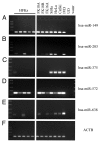Methylation-mediated transcriptional repression of microRNAs during cervical carcinogenesis
- PMID: 23324622
- PMCID: PMC3592908
- DOI: 10.4161/epi.23605
Methylation-mediated transcriptional repression of microRNAs during cervical carcinogenesis
Abstract
Deregulated expression of microRNAs (miRNAs) is common and biologically relevant in cervical carcinogenesis and appears only partly related to chromosomal changes. We recently identified 32 miRNAs showing decreased expression in high-grade cervical intraepithelial neoplasia (CIN) and carcinomas not associated with a chromosomal loss, 6 of which were located within a CpG island. This study aimed to investigate to what extent these miRNAs are subject to DNA methylation-mediated transcriptional repression in cervical carcinogenesis. Methylation-specific PCR (MSP) analysis on a cell line panel representing different stages of human papillomavirus (HPV) induced transformation revealed an increase in methylation of hsa-miR-149, -203 and -375 with progression to malignancy, whereas expression of these miRNAs was restored upon treatment with a demethylating agent. All three miRNAs showed significantly increased levels of methylation in cervical carcinomas, whereas methylation levels of hsa-miR-203 and -375 were also significantly increased in high-grade CIN. A pilot analysis showed that increased hsa-miR-203 methylation was also detectable in HPV-positive cervical scrapes of women with high-grade CIN compared with controls. Similar to recent findings on hsa-miR-375, ectopic expression of hsa-miR-203 in cervical cancer cells decreased both the proliferation rate and anchorage independent growth. We found evidence for methylation-mediated transcriptional repression of hsa-miR-149, -203 and -375 in cervical cancer. Methylation of the latter two was already apparent in precancerous lesions and represent functionally relevant events in HPV-mediated transformation. Increased hsa-miR-203 methylation was detectable in scrapes of women with high-grade CIN, indicating that methylated miRNAs may provide putative markers to assess the presence of (pre)cancerous lesions.
Keywords: CIN lesion; DNA methylation; HPV; MSP; microRNA; squamous cell carcinoma.
Figures




Similar articles
-
Methylation of the hsa-miR-124, SOX1, TERT, and LMX1A genes as biomarkers for precursor lesions in cervical cancer.Gynecol Oncol. 2018 Sep;150(3):545-551. doi: 10.1016/j.ygyno.2018.06.014. Epub 2018 Jun 28. Gynecol Oncol. 2018. PMID: 29960712
-
Aberrant methylation-mediated silencing of microRNAs contributes to HPV-induced anchorage independence.Oncotarget. 2016 Jul 12;7(28):43805-43819. doi: 10.18632/oncotarget.9698. Oncotarget. 2016. PMID: 27270309 Free PMC article.
-
MicroRNA Biomarkers of High-Grade Cervical Intraepithelial Neoplasia in Liquid Biopsy.Biomed Res Int. 2021 Apr 13;2021:6650966. doi: 10.1155/2021/6650966. eCollection 2021. Biomed Res Int. 2021. PMID: 33954190 Free PMC article.
-
Epidemiology of cervical intraepithelial neoplasia: the role of human papillomavirus.Baillieres Clin Obstet Gynaecol. 1995 Mar;9(1):1-37. doi: 10.1016/s0950-3552(05)80357-8. Baillieres Clin Obstet Gynaecol. 1995. PMID: 7600720 Review.
-
'Drawing' a Molecular Portrait of CIN and Cervical Cancer: a Review of Genome-Wide Molecular Profiling Data.Asian Pac J Cancer Prev. 2015;16(11):4477-87. doi: 10.7314/apjcp.2015.16.11.4477. Asian Pac J Cancer Prev. 2015. PMID: 26107190 Review.
Cited by
-
Cell death pathways and viruses: Role of microRNAs.Mol Ther Nucleic Acids. 2021 Mar 19;24:487-511. doi: 10.1016/j.omtn.2021.03.011. eCollection 2021 Jun 4. Mol Ther Nucleic Acids. 2021. PMID: 33898103 Free PMC article. Review.
-
A Comprehensive Review of Dysregulated miRNAs Involved in Cervical Cancer.Curr Genomics. 2014 Aug;15(4):310-23. doi: 10.2174/1389202915666140528003249. Curr Genomics. 2014. PMID: 25132800 Free PMC article.
-
Clinical implications of (epi)genetic changes in HPV-induced cervical precancerous lesions.Nat Rev Cancer. 2014 Jun;14(6):395-405. doi: 10.1038/nrc3728. Nat Rev Cancer. 2014. PMID: 24854082 Review.
-
Methylation of miR-129-5p CpG island modulates multi-drug resistance in gastric cancer by targeting ABC transporters.Oncotarget. 2014 Nov 30;5(22):11552-63. doi: 10.18632/oncotarget.2594. Oncotarget. 2014. PMID: 25344911 Free PMC article.
-
Identification of proteins' expression pathway and the effective miRNAs for the treatment of human papillomavirus-induced cervical cancer: in-silico analyses-experimental research.Ann Med Surg (Lond). 2024 Aug 30;86(10):5784-5792. doi: 10.1097/MS9.0000000000002513. eCollection 2024 Oct. Ann Med Surg (Lond). 2024. PMID: 39359748 Free PMC article.
References
-
- Botezatu A, Goia-Rusanu CD, Iancu IV, Huica I, Plesa A, Socolov D, et al. Quantitative analysis of the relationship between microRNA‑124a, -34b and -203 gene methylation and cervical oncogenesis. Mol Med Report. 2011;4:121–8. - PubMed
Publication types
MeSH terms
Substances
LinkOut - more resources
Full Text Sources
Other Literature Sources
Medical
Research Materials
